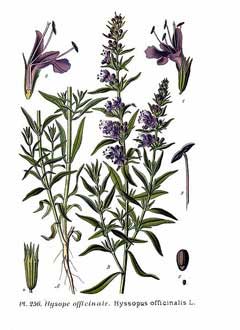Hyssop
 Also Known As:
Also Known As:
Hysope
Officinale.
Scientific Name:
Hyssopus
officinalis.
Family:
Lamiaceae/Labiatae.
People Use This For:
Hyssop is
used for liver and gallbladder conditions, intestinal inflammation,
coughs,
the common cold, respiratory infections, sore throat, asthma, urinary
tract
infection, flatulence and colic, anorexia, poor circulation, painful periods, and
for digestive and intestinal problems.
Safety:
No
concerns regarding safety when used orally in amounts commonly found in foods.
Generally Recognized as Safe (GRAS) status in the US.(12)
Pregnancy
and Lactation: Refer to a Medical Herbalist.
Effectiveness:
There is
insufficient scientific information available about the effectiveness of hyssop.
Mechanism of Action:
The
applicable parts of hyssop are the above ground parts. Constituent marrubiin (13)
has
cardioactive effects and stimulates bronchial secretions. (14)
Caffeic acid
and tannins may be the active constituents of the dried leaves. Extracts show
antiviral activity against herpes simplex virus and HIV in vitro. (15,13)
Adverse Reactions:
None
reported with tincture or infusion.
Interactions with Herbs & Supplements:
None
known.
Interactions with Drugs:
None
known.
Interactions with Foods:
None
known.
Interactions with Lab Tests:
None
known.
Interactions with Diseases or Conditions:
None
reported with tincture or infusion.
Dosage/Administration:
Dr
Clare’s Blends:
To check
Oral:
Typically people take two 445 mg capsules containing the hyssop herb
three
times daily. (16)
Some
people take 10-15 drops of the hyssop extract (12-14% by volume) in water two
to three times daily. (17)
People
also consume or gargle the hyssop tea three times daily. (18)
The tea
is prepared by steeping 1-2 teaspoons of the dried hyssop flower tops in 150 mL
boiling water for 10-15 minutes and then straining. Avoid internal use of
hyssop oil due to possible neurotoxicity.
Specific References: HYSSOP
12. FDA.
Center for Food Safety and Applied Nutrition, Office of Premarket Approval,
EAFUS: A
food
additive database. Available at: vm.cfsan.fda.gov/~dms/eafus.html.
13. Leung
AY, Foster S. Encyclopedia of Common Natural Ingredients Used in Food, Drugs
and
Cosmetics.
2nd ed. New York, NY: John Wiley & Sons, 1996.
14.
Newall CA, Anderson LA, Philpson JD. Herbal Medicine: A Guide for Healthcare Professionals.
London, UK: The Pharmaceutical Press, 1996.
15. The
Review of Natural Products by Facts and Comparisons. St. Louis, MO: Wolters
Kluwer Co., 1999.
16.
Manufacturer: Nature's Way. Springville, UT.
17.
Manufacturer: Nature's Answer. Hanppange, NY.
18.
Fetrow CW, Avila JR. Professional's Handbook of Complementary & Alternative
Medicines. 1st ed. Springhouse, PA: Springhouse Corp., 1999.